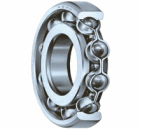Here is a little quick reference guide that explains these bearing codes in detail.
(2 Min Read)
Lets use a 6309 2Z/C3 as an example:
S 6302 2RS
^ ^^^^ ^^
Prefix Code Suffix
Prefix:
- K - Cage with roller elements
- L - Removable bearing ring
- R - Ring with roller set
- S - Roll body of stainless steel
- W - Stainless steel deep groove ball bearing
Code:
(6)902 - This first number relates to the bearing type
1-Self-Aligning Ball Bearing
This kind of ball bearing has a spherical outer race, allowing the axis of the bearing to "wander around". This is important because misalignment is one of the big causes of bearing failure.
2-Barrel and Spherical Roller Bearings
3-Tapered Roller Bearing
4-Deep Groove Double-Row Ball Bearing
5-Axial Deep Groove Ball Bearing
6-Deep Groove Ball Bearing (Single row)
 |
| Deep Groove Ball Bearing |
7-Single-Row Angular Contact Bearing
8-Axial Cylindrical Roller Bearings
6(3)09 - This second number relates the bearing series, which reflects the robustness of the bearing. As you go up the scale below from 9 to 4 the inner and outer race thickness will usually increase along with the ball size, this will be to help cope with extra load.
- 9 - Very thin section
- 0 - Extra light
- 1 - Extra light thrust
- 2 - Light
- 3 - Medium
- 4 - Heavy
63(09) - The 3rd and 4th digits of the bearing number relate to the bore size of the bearing, numbers 00 to 03 have a designated bore size depending on the number.
- 00 - 10mm
- 01 - 12mm
- 02 - 15mm
- 03 - 17mm
*Note: Numbers over 03 simply have a bore size which is 5 times that of the 3rd and 4th digit.
Suffix:
- 2 RS - Bearing with rubber seal on both sides. RS provides a better seal but more rolling friction than 2Z.
- RS - Bearing with rubber seal on one side, one side open.
- 2 Z / ZZ - Bearing with a metal seal on both sides.
- Z - Bearing with a metal seal on one side, one side open.
- E - Reinforced Design
- P2 - Highest precision
- K - Bearing with taper bore
The standards of internal clearance that bearings are manufactured to are quoted by a C then a number or for standard clearance bearings are denoted to be CN clearance which is never stated and places the bearing between C2 and C3 Clearance.Standard bearings are what are known as CN clearance but this is never stated in the bearing number thus 6205CN would normally be stated as just 6205.
C3, C4 and C5 bearings are bearings that have an additional internal radial clearance to cope with high speed environments where excess heat is generated. They are not suited to environments where critical alignment is required from the onset e.g. Where blades and cutters are set up to each other. Applications like motorcycle wheels or bicycle wheels do not require C3 rated bearings.
- C2 is less than normal so the bearing is tighter (designed for slower moving more precise applications that require little or no play in the bearings where the temperature remains fairly constant.
- C3 is designed for hot running environments; engines etc. where the bearing temp could reach 100deg or more.
- C4 more extreme temperature applications and higher speed environments.
- C5 the highest clearance bearing available, are extremely loose to start and can knock until at operating speeds and temperature.
Unless the bearing you are replacing specifically says C3 on it then you should not replace it with a C3 bearing, C3 Bearings are loose to the feel from new and often people complain at the quality of the bearing being poor and having more movement than the one they are replacing. C4 and C5 are even looser still than C3 clearance bearings.






